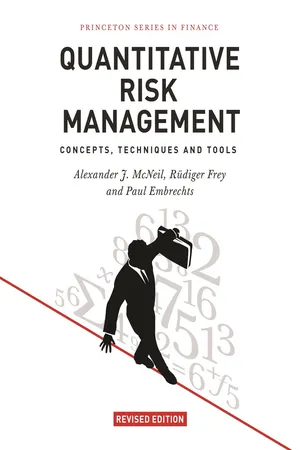
Quantitative Risk Management
Concepts, Techniques and Tools - Revised Edition
- 720 pages
- English
- PDF
- Available on iOS & Android
Quantitative Risk Management
Concepts, Techniques and Tools - Revised Edition
About this book
This book provides the most comprehensive treatment of the theoretical concepts and modelling techniques of quantitative risk management. Whether you are a financial risk analyst, actuary, regulator or student of quantitative finance, Quantitative Risk Management gives you the practical tools you need to solve real-world problems.
Describing the latest advances in the field, Quantitative Risk Management covers the methods for market, credit and operational risk modelling. It places standard industry approaches on a more formal footing and explores key concepts such as loss distributions, risk measures and risk aggregation and allocation principles. The book's methodology draws on diverse quantitative disciplines, from mathematical finance and statistics to econometrics and actuarial mathematics. A primary theme throughout is the need to satisfactorily address extreme outcomes and the dependence of key risk drivers. Proven in the classroom, the book also covers advanced topics like credit derivatives.
- Fully revised and expanded to reflect developments in the field since the financial crisis
- Features shorter chapters to facilitate teaching and learning
- Provides enhanced coverage of Solvency II and insurance risk management and extended treatment of credit risk, including counterparty credit risk and CDO pricing
- Includes a new chapter on market risk and new material on risk measures and risk aggregation
Frequently asked questions
- Essential is ideal for learners and professionals who enjoy exploring a wide range of subjects. Access the Essential Library with 800,000+ trusted titles and best-sellers across business, personal growth, and the humanities. Includes unlimited reading time and Standard Read Aloud voice.
- Complete: Perfect for advanced learners and researchers needing full, unrestricted access. Unlock 1.4M+ books across hundreds of subjects, including academic and specialized titles. The Complete Plan also includes advanced features like Premium Read Aloud and Research Assistant.
Please note we cannot support devices running on iOS 13 and Android 7 or earlier. Learn more about using the app.
Information

Table of contents
- Cover
- Title
- Copyright
- Dedication
- Contents
- Preface
- I An Introduction to Quantitative Risk Management
- II Methodology
- III Applications
- IV Special Topics
- Appendix
- References
- Index